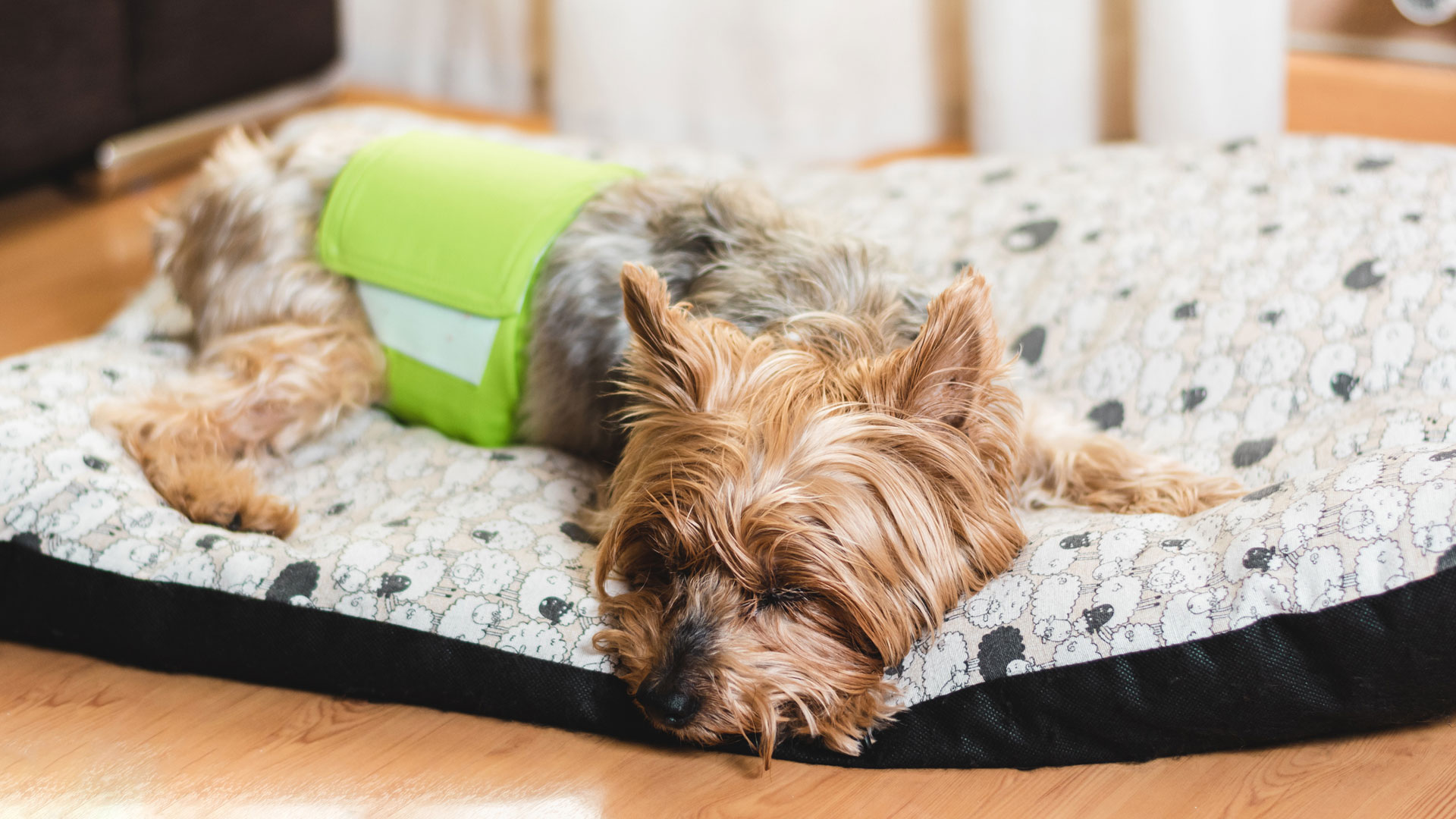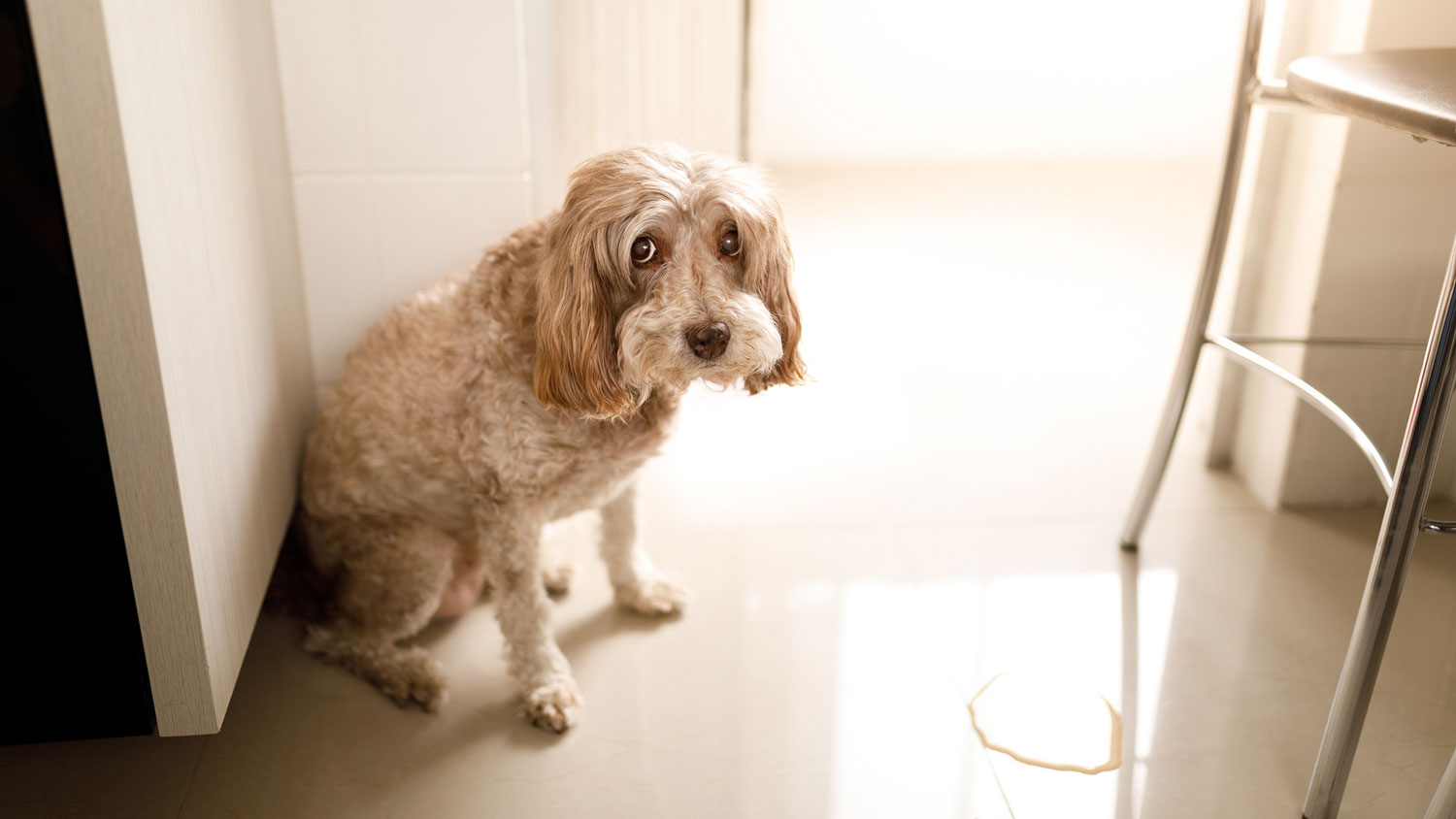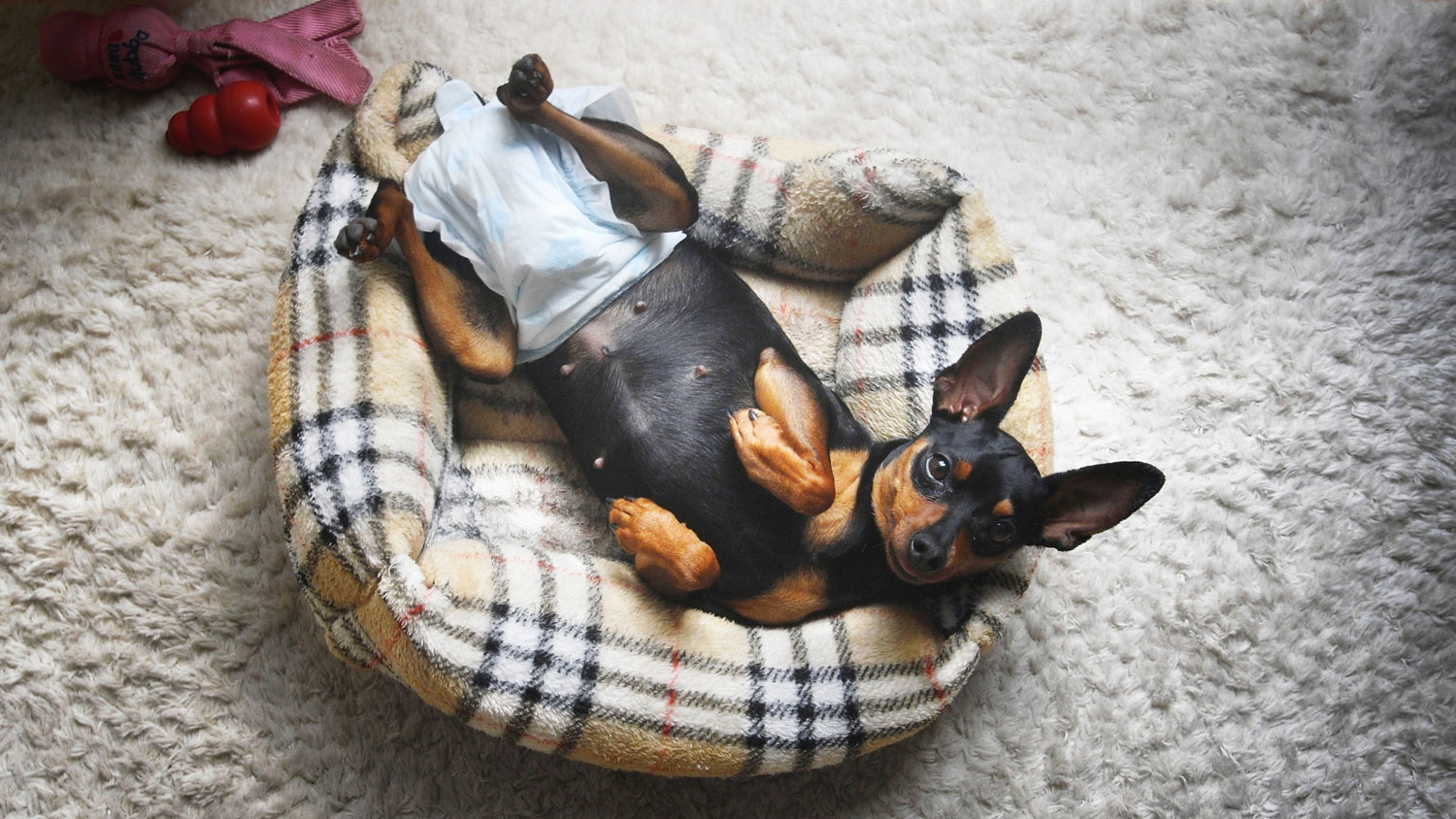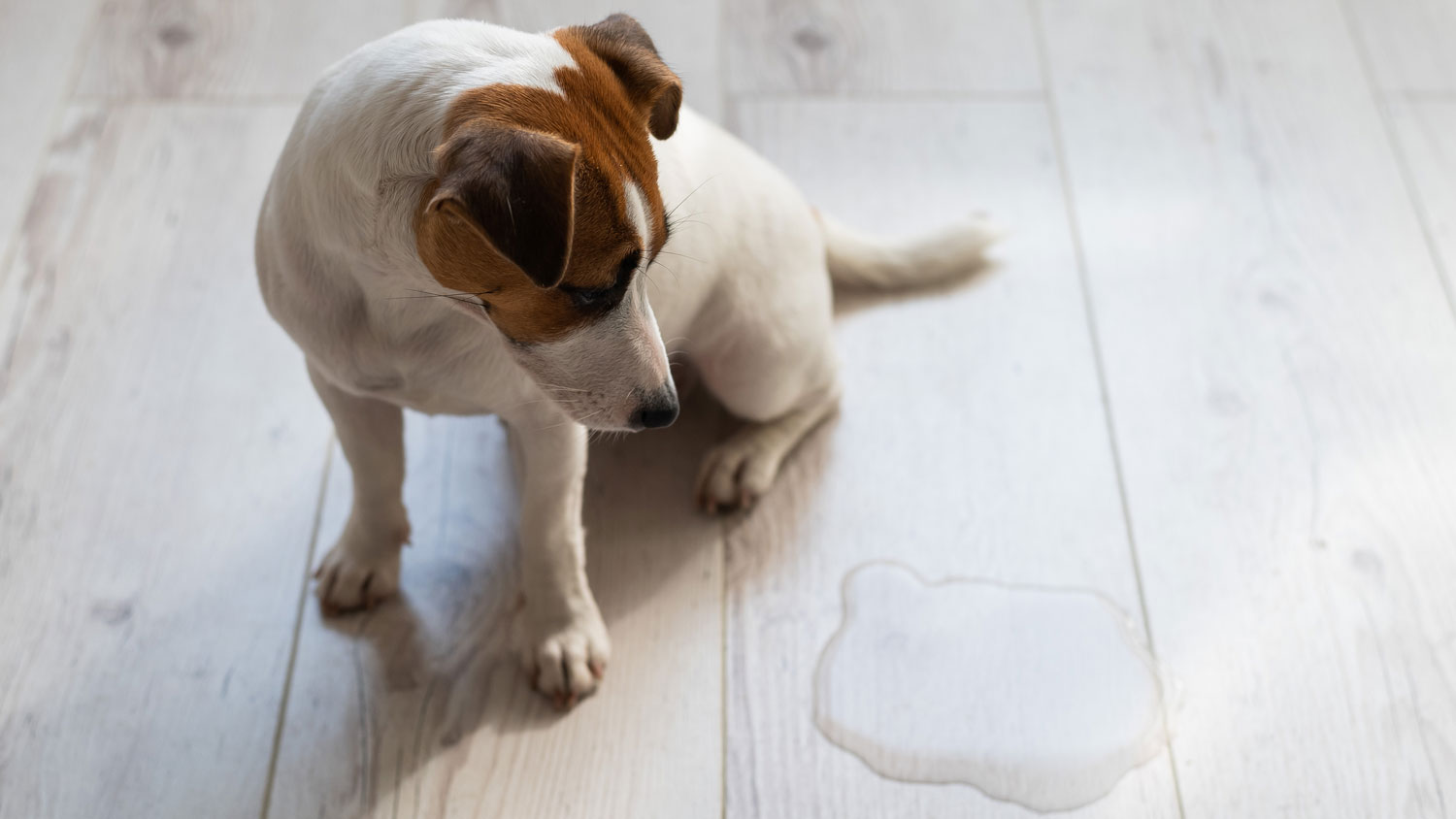Incontinence in dogs: Vet's guide to causes and treatment
Curious about incontinence in dogs? Our vet covers canine incontinence and what to do about it

Encountering incontinence in dogs can be a bit of a shock. Especially when your toilet trained pooch starts urinating in the home, you might be wondering if incontinence could be the cause.
Incontinence in dogs is fairly common, especially in older age or in some conditions, so it could be the reason your dog has started wetting the bed or peeing in the house.
Read on to discover what canine incontinence is, what causes it, and what you can do to help your furry pal. And if you need specific help after an accident, you could always check our guide to how to get dog pee out of the carpet and floors.
What is incontinence in dogs?
Firstly, let’s take a look at what incontinence is. Incontinence is defined as a lack of voluntary control over urination and/or defecation. In other words, your dog can’t control when he pees or poos – it comes out without warning. Incontinence can be only urinary incontinence (just pee), just fecal incontinence (just poo) or both pee and poop.
A lot of people get confused when their dog is toileting in the house and think this is incontinence, but if your dog knows that he’s toileting his pee is under voluntary control, so this is an accident, not incontinence. Separating the two can be tricky though, so let’s look at the signs of incontinence in dogs.
Signs of incontinence in dogs
As discussed above, incontinence involves a loss of voluntary control over the bladder/bowel. This means that the symptoms of incontinence are usually accidents in the house, wetting the bed, or urine dripping constantly. Other signs of incontinence in dogs include:
- Dripping urine or feces
- Wet patches where they have been sleeping, or pee on the bed
- Puddle of urine near bed (it spills out as they get up)
- Sore skin near bottom and back of legs from being constantly wet with urine
- Matted fur and feces around the bottom
- Licking penis or vulva more (to clean urine off)
When trying to decide if your dog is incontinent, you need to decide if they know whether they’re going to the toilet.
If they are having accidents by the back door, that suggests they knew they needed to pee or poo and didn’t make it out in time – there’s a big difference between that and a dog that has no idea that they are passing urine or feces.
Your vet will ask you questions to help determine whether your dog knows they’re toileting or not.

What causes incontinence in dogs?
There are several causes of incontinence in dogs, including toxins, disease and injury:
USMI in dogs
The most common cause of urinary incontinence in dogs is urethral sphincter mechanism incompetence (USMI).
While the exact cause of USMI is not known, it affects spayed (neutered) female dogs, with about 5% of spayed dogs going on to develop USMI. According to the same study, dogs over 15kg were seven times more likely to develop USMI than smaller dogs.
This could have something to do with the fact that larger dogs reach maturity more slowly, as this study showed a decrease in the likelihood of USMI when owners of larger dogs wait until later in life to neuter them. There is also some new evidence that lower back pain may be implicated in some cases of USMI in dogs.
Ectopic ureter
Another cause of urinary incontinence is an ectopic ureter. This is when the tube that goes from the kidney to the bladder connects in the wrong place. Dogs are born with this problem, so it’s usually diagnosed in young dogs.
Urinary incontinence can also happen in males, where it is usually caused by prostate problems (males only) and perineal hernia (more common in males). It affects about 1% of all male dogs, but unlike in females is not more likely in neutered dogs or heavier dogs.
Disease or injury
Urinary incontinence in dogs can also be caused by some toxins, as well as diseases and injuries like:
- Spinal disease or damage
- Urine infections
- Crystals and stones in the urine
- Damage to the urinary tract
Fecal incontinence is rarer than urinary incontinence and is usually caused by damage to the spine. Small volumes of feces may leak in dogs experiencing a particularly bad bout of diarrhea.
Types of dogs most likely to be incontinent
Middle-aged to older spayed female dogs are most likely to be incontinent. Older male dogs are also more likely than the average dog to become incontinent, especially if they are a Bull Mastiff, Red Setter, Fox Terrier, Bulldog, or Boxer. However, any dog can suffer from incontinence.
How is incontinence in dogs diagnosed?
Your vet will start by asking some questions — a thorough history can help determine if your dog is truly incontinent or if they are having problems getting to the toilet in time. They will examine your dog, looking for sore skin as well as any sign of a cause. In males, this is likely to include a prostate exam.
They will also ask for a urine sample from your dog, so take one to your appointment if you can. This is usually easy to collect with a wide, flat tray such as a clean takeaway container. The urine sample can be examined for bacteria, crystals, blood, and concentration.
In some cases, your dog will need further investigations, especially if they have recurring incontinence or the cause isn’t immediately obvious. This might include ultrasound exams, radiographs (x-rays) or even a cystoscope – putting a camera into the bladder to visualize any problems.

Treating incontinence in dogs
Some cases of incontinence will resolve when the underlying cause is treated. Examples include urine infections and bladder stones. For these cases, your dog may be placed on medications like antibiotics or asked to start a special diet. In some cases, surgery will be needed to correct the underlying cause of the incontinence— for instance spinal problems, perineal hernias, and some bladder stones.
In some cases, including USMI, your dog will need to go on lifelong medication. Up to 97% of USMI cases resolve with medication, although they will recur if the medication is stopped. Your vet might also recommend a pain relief trial to see whether back pain is a cause of your dog’s USMI.
Unfortunately, there are far less well-established methods for treating fecal incontinence. While some dogs will recover, ongoing fecal incontinence is often a cause for euthanasia.
Can incontinence in dogs be temporary?
Incontinence in dogs can be temporary if caused by a disease or injury, and many dogs will make a complete recovery. For instance, in dogs with a urinary infection or urinary stones, the incontinence will resolve once the underlying cause is treated.
Dogs with spinal cord damage or disease are less likely to make a recovery, although it depends on the type of damage. USMI is a permanent cause of incontinence, but it can be managed with medication.

After graduating as a veterinarian from the University of Nottingham, Dr Joanna Woodnutt went on to practice companion animal medicine in the Midlands. She quickly developed a love of consulting and helping clients with medical problems such as dermatology, behavior and nutrition, and has written for countless online and print publications.
Managing incontinence in dogs at home
If your dog has incontinence, you might be wondering how you can manage them at home. Well, the first tip is to go see your vet to get treatment started – it will make a big difference in almost all cases.
You’ll need to care for their skin. This might mean applying a barrier cream like Vaseline to the area to prevent urine scalding. If your dog is dripping poop, clipping the hair around the back end will help you to keep the area clean. If they’re licking a lot, they may need a plastic e-collar while the skin heals.
Some people use dog diapers to help with incontinence in dogs and this is certainly an option. However, you’ll need to change the nappy frequently, allow them diaper-free time, and take extra care of the area, as diapers can cause the skin to become sore.
Try to keep your dog on hard floors that are easy to clean, and make sure you wash their bed and any furnishings they sleep on. Regular washing may be necessary until your dog becomes continent again.

When to worry about incontinence in dogs
Incontinence in dogs is never normal and you should contact your vet for an appointment as soon as you notice a problem.
It’s common for people to consider incontinence a normal part of aging but this isn’t the case – it’s a medical problem that can often be treated. Ongoing costs for incontinence medications, if necessary, are not high and are important to improve your dog’s quality of life.
Is incontinence in dogs a reason to put a dog down?
Almost all cases of urinary incontinence can be improved, so it’s generally recommended that you trial treatment for your dog rather than opting to euthanize them. However, this will depend on your dog’s other illnesses and the cause – in some cases you may make the decision that incontinence is just one thing too much, and it’s time to say goodbye.
Fecal incontinence is much less likely to improve, and it has more of an effect on ongoing quality of life. In this situation, your vet might have a discussion with you about putting your dog to sleep. Remember though, it’s always your choice and you can ask about other options instead.
Summary
Urinary incontinence in dogs is fairly common, and most cases can be treated entirely or prevented from reoccurring depending on the cause. Fecal incontinence, on the other hand, is generally more serious and a lot rarer.
You should always visit your vet if your notice incontinence in your dog – it’s not a normal part of aging and in many cases significant improvements can be made to their quality of life without running up a huge bill.
PetsRadar Newsletter
Get the best advice, tips and top tech for your beloved Pets
After graduating as a vet from the University of Nottingham, Dr Joanna Woodnutt went on to practice companion animal medicine in the Midlands. Since then, she has also written for countless online and print publications and is a regular contributor for Edition Dog Magazine.
